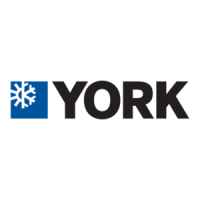
Do you have a question about the York CURBPAK CP170 and is the answer not in the manual?
| Brand | York |
|---|---|
| Model | CURBPAK CP170 |
| Category | Air Handlers |
| Language | English |
Explains safety symbols used in the document to alert readers to potential hazards.
Guidance on selecting an appropriate installation location for the CurbPak unit, considering structural strength and environmental factors.
Specifies maximum roof pitch allowances for unit installation and mounting recommendations.
Details the assembly and installation of the roof curb, including package contents and site requirements.
Instructions for assembling sections of the unit that were shipped separately before setting it on the curb.
Information on preparing and adjusting fan isolators (rubber-in-shear or spring) for proper operation.
Discusses VAV applications using YORK Air-Modulator (VFD) and variable inlet vanes.
Details the benefits and operation of the Air-Modulator VFD for VAV systems.
A comprehensive checklist of items to verify before starting the unit for the first time.
Essential checks to perform on the unit's components and installation before initial operation.
A crucial warning about operating motors within their amperage limits.
Detailed explanation of locking ring variable pitch sheaves and their adjustment.
Maintenance tasks categorized by frequency: monthly and one to six months.
Details on lubricating fan bearings, including frequency, procedure, and lubricant type.
Recommendations for motor bearing lubrication, including grease type and compatible lubricants.
Inspection and lubrication requirements for variable inlet vane bearings.
Instructions for removing and installing forward curved fan wheels, emphasizing balance preservation.
General guidance on handling and cleaning fan shaft bearing areas during removal and replacement.
Specific steps for shaft inspection, bearing alignment, and housing installation.
Detailed explanation of the eccentric self-locking collar mechanism for securing bearings to the shaft.
Provides torque values for tightening set screws used in bearing locking devices.
Introduces troubleshooting for HVAC air systems, focusing on fan functions and pressure measurement.
Explains the construction and use of a Pitot tube for measuring air velocity and pressure in HVAC systems.
Provides troubleshooting steps when the unit's airflow (CFM) is lower than specified.